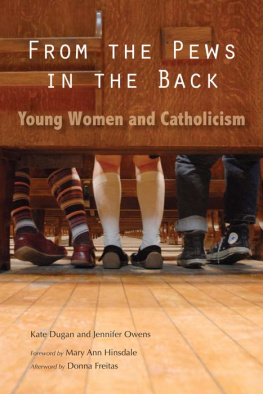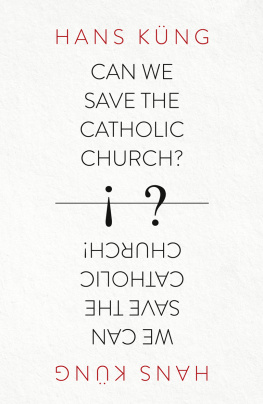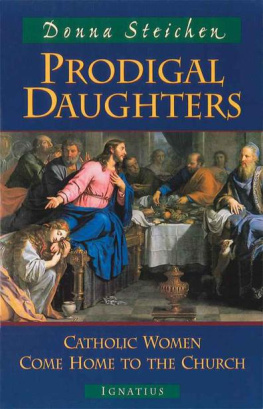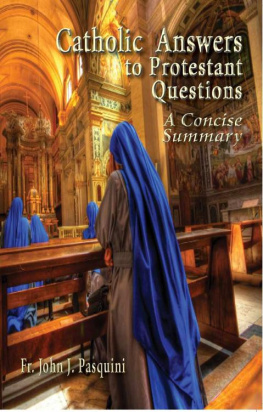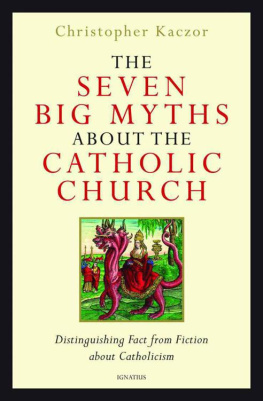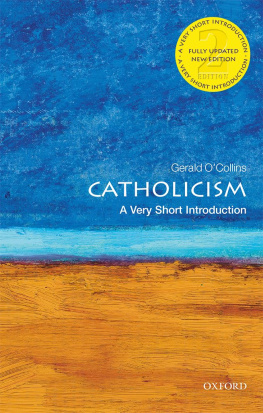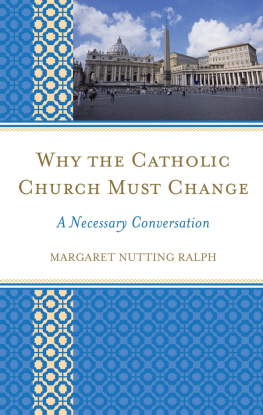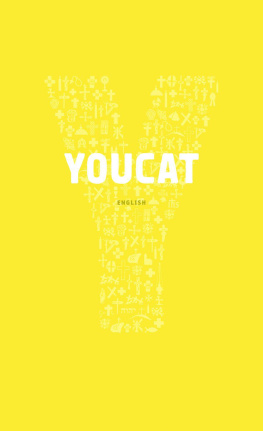Cover design by Ann Blattner. Photo by Monica Haller.
Pseudonyms have been used in a number of these essays.
2009 by Order of Saint Benedict, Collegeville, Minnesota. All rights reserved. No part of this book may be reproduced in any form, by print, microfilm, microfiche, mechanical recording, photocopying, translation, or by any other means, known or yet unknown, for any purpose except brief quotations in reviews, without the previous written permission of Liturgical Press, Saint Johns Abbey, PO Box 7500, Collegeville, Minnesota 56321-7500. Printed in the United States of America.
From the pews in the back: young women and Catholicism / edited by Kate Dugan and Jennifer Owens.
p. cm.
ISBN 978-0-8146-3258-1 (pbk.)
Ebook ISBN 978-0-8146-3902-3
1. Catholic womenReligious lifeUnited States. 2. Young womenReligious lifeUnited States. I. Dugan, Kate. II. Owens, Jennifer.
Foreword
When Harvard Divinity School students Jen Owens and Kate Dugan contacted me a few years ago to ask my advice about a book project they were mulling over I was immediately eager to hear more about it. Having taught young Catholic women in undergraduate theology and graduate ministry courses for the past twenty-five years, I am often asked, Are young people still interested in the Catholic Church? When the question is posed even more specifically, as in, What are young Catholicwomen thinking about the Catholic Church today? it gets even trickier.
Since I am no longer a young Catholic woman (at least by the calendars calculation), I resolve to fend off these invitations saying, Why not ask them yourselves? But many people who ask me such questions either dont have much contact with young adults (especially not with young Catholic women), or I soon learn that what they really want is for me to tell them what can be done about the fact that their son, daughter, or grandchildren dont go to church anymore.
So, I proceed to give an anecdote or two from my teaching experience and finally end up saying something like, Well, you know, according to the social scientists who study the millennial generation, the clich Im spiritual, but not religious captures the attitude of many young people. I tend to agree generally that young people do not seem to be as invested in religious institutions as were previous generations; however, I also am convinced that social scientists have tended to neglect the female segment of millennials and hardly anyone has been listening to younger Catholic women.
I confess that I have weakened and have twice committed my thoughts to print on the subject of what young Catholic women are looking for from the church, but in each case my attempts to answer that question always end with an insistent, mantra-like they simply want to be heard. But no one seems to be listening! Thus, it brings me great joy to see Jen and Kates project come to fruition in From the Pews in the Back, and I am honored to be asked to include a few words here. But perhaps what is most exciting is that now, young Catholic women are saying it for themselves.
The collection that Jen and Kate have assembled rings true with the countless conversations and stories I have heard from young Catholic women. As Jen and Kate note, they are simply presenting a snapshot of young female voices within U.S. Catholicism. What I find especially appealing in these reminiscences, however, is that they are giving voice to the experience of a new, postVatican II generation of progressive laywomen who desire to claim their rightful role in the church they call home.
These essays shine a light on an underrepresented segment of that James Joycean version of Catholicism where here comes everybody. The women whose reflections are assembled heresingle, married, lesbian, straight, Anglo, Latina, Asian-Americanare most of all real. Yes, they are a highly educated and theologically sophisticated group. Their religious identity has been forged in honesty, unflinchingly facing both the beauty and the beastliness of Catholicism. I am glad that their bushel baskets have been overturned so that my generation can see the bright, shining light of their hopes for the future of the church. Reminiscences of family meals, the songs, prayer, and poetry that make up the rich sacramental imagination of Catholicism mark these reflections. In them we also read how the challenging, prophetic words of Jesus, reaching out to those most on the marginthe excluded, the vulnerable, the invisiblestrengthen these womens resolve to be Catholic role models for others, especially their own children. In every story, even the ones by women who have become angry and disenchanted, there is both a longing for and a refusal to give up the conviction that Catholicism is home.
This is a book that I would give to anyone who wonders what young Catholic women are thinking about the church today. To be sure, there will be some who will shake their heads and think, These smart women are wasting their time, or, Theyll get over it (some may even consider them deluded). I hope, however, that older, progressive Catholics of my generation will perhaps find in these younger women the courage to carry on and that young Catholics seeking a church that not only preaches justice but acts justly will be heartened to find they are not alone.
Jen Owens and Kate Dugan are certainly conscious that there is no one-size-fits-all young Catholic woman. But they have discerned well that the voices of young women living on the edge, those who constantly find themselves negotiating between frustration with the patriarchy of the church and the threat of forced spiritual eviction from their religious home deserve to be heard. I applaud the courage, hope, and passionate ambivalence of these young women.
I wager that these first-person narratives will be a powerful spiritual resource for anyone who works with young Catholic women or who just wants to understand where they are coming from. I speak particularly to the ordained (bishops, priests, and deacons) who minister to and collaborate with women such as those represented in this volume. Whether one agrees with everything these authors are saying is not the issue. Listening to them, however, is vital to understanding an important segment of generation next.
So, if you really are interested in listening to young Catholic women, I invite you to open yourself up to the stories collected in this book. I guarantee that if you do, you will learn a lot, you will laugh a lot, and at times, perhaps simply lament. But my fondest hope is that these essays will serve as a springboard for much-needed intergenerational conversations about what the Spirit is doing among young Catholic women at the beginning of this third millennium.
Mary Ann Hinsdale, IHM, PhD
Boston College
February 1, 2009
Mary Ann Hinsdale, Is Anybody Listening? Catholic College Women Talk about the Church, The Catholic World

